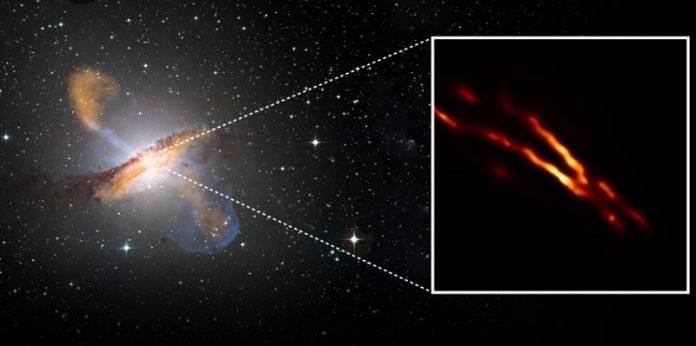
The Event Horizon Telescope Collaboration, which is known for capturing the first image of a black hole in 2019, has now imaged the heart of another galaxy – Centaurus A – in unprecedented detail.
Taking advantage of the collaboration’s global array of telescopes, the international team’s observations reveal an enormous glowing jet of gas and dust being flung from the supermassive black hole at the galaxy’s center.
Centaurus A is located over 13 million light-years away and glows brightly at the longest wavelengths of light – radio wavelengths.
Researchers found that the jet is emitting light only from its outer edges, which challenges theoretical models of jets.
“This is the first time that the base of astrophysical jets is imaged at this resolution,” said EHT collaborator Chi-kwan Chan, an associate research professor in UArizona’s Steward Observatory who is part of the data analysis team.
“We were surprised to find that the structure is narrow, with emission radiating only from its outermost edges.”
The work, published in Nature Astronomy, was led by Michael Janssen from the Max Planck Institute for Radio Astronomy in Bonn, Germany, and Radboud University in Nijmegen, Netherlands.
“EHT does not capture a picture directly. Instead, it records petabytes of radio waveform data from many radio telescopes around the world, which is then used to reconstruct the final picture,” said paper co-author and UArizona professor of astronomy Dan Marrone.
Marrone led a team of UArizona scientists and students in collecting data using the Submillimeter Telescope on Mount Graham in Arizona and the South Pole Telescope in Antarctica.
At radio wavelengths, which are longer than all other wavelengths of light, Centaurus A appears to be one of the largest and brightest objects in the night sky.
After it was identified as one of the first known radio sources outside the Milky Way in 1949, Centaurus A has been studied extensively across a variety of wavelengths of light. At the center of Centaurus A lies a black hole with the mass of 55 million suns.
For scale, the supermassive black hole imaged in 2019 in the M87 galaxy is as massive as 6 1/2 billion suns, and the black hole in the center of our own galaxy is equivalent in mass to about 4 million suns.
Understanding Jets
Supermassive black holes at the center of galaxies like Centaurus A feed off nearby gas and dust attracted by their intense gravitational pull.
However, some of the surrounding gas and dust particles escape moments before capture and are blown far out into space, giving birth to jets – one of the most mysterious and energetic features of galaxies.
Astronomers have relied on different models of how matter behaves near black holes to better understand this process, but they still do not know exactly how jets are launched from a black hole’s central region and how they can extend over scales that are larger than their host galaxies without fanning out.
The EHT Collaboration aims to solve that mystery.
Compared to previous high-resolution observations, the jet launched in Centaurus A is imaged at a tenfold higher frequency, resulting in a resolution 16 times sharper than what was possible with previous radio telescopes.
“This allows us for the first time to see and study an extragalactic radio jet on scales smaller than the distance light travels in one day,” Janssen said.
“We see up close and personally how a monstrously gigantic jet launched by a supermassive black hole is being born.”
Before EHT, astronomers were not able to pinpoint the jet’s source. The jet appeared to be amorphous and 16 times as wide as the moon in the sky.
But EHT imaged the jet in such detail that the collaboration was able to pinpoint its origin near the black hole in a region as small as the width of an apple on the moon when projected on the sky. That is a magnification factor of 1 billion.
The detailed image also reveals the surprisingly bright edges of the jet compared to the center. This phenomenon is known from other jets but has never been seen so pronounced.
“Now we are able to rule out theoretical jet models that are unable to reproduce this edge brightening.
It’s a striking feature that will help us better understand jets produced by black holes,” said co-author Matthias Kadler, a professor of astrophysics at the University of Würzburg in Germany and leader of the TANAMI program, which stands for Tracking Active Galactic Nuclei with Australian-South-African Milliarcsecond Interferometry.
Future Observations
With the new EHT observations of Centaurus A jet, the likely location of the black hole has been identified as the launching point of the jet.
Based on this location, the researchers predict that future observations at an even shorter wavelength and higher resolution would be able to photograph the central black hole of Centaurus A.
However, this will not be possible with the EHT, and instead will require the use of space-based observatories.
“These data are from the same observing campaign that delivered the famous image of the black hole in M87,” said Heino Falcke, EHT board member and professor of astrophysics at Radboud University. “The new results show that the EHT provides a treasure trove of data on the rich variety of black holes, and there is still more to come.”
Data for the study are stored and made publicly available in CyVerse, the National Science Foundation’s premier data management platform led by UArizona.
Since its inception, the EHT collaboration has relied upon CyVerse’s computational infrastructure to share and manage the project’s massive datasets among its global network of researchers.
Written by University Communications and EHT Collaboration.




